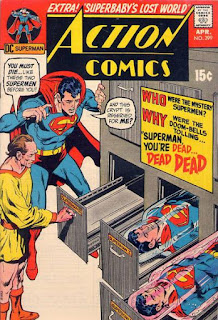Witching Hour #14 (On Sale: February 11, 1971), has a cover by
Neal Adams, Al Williamson, and
Carlos Garzon.
This beauty is one of the great comics of 1971 and a final treat to us all from departed editor Dick Giordano. Murray Boltinoff never put out a book this good in his life. The framing sequence throughout the book is drawn by George Tuska and is notably shortened this issue, after the initial first page being delegated to 1/2 to 1/3 pages. But hey, it is not the reason this book is so grand. Really, check this out...
We begin with "Fourteen Months" by Gerry Conway and Jeffrey Catherine Jones. It will be 27 years before Jones will draw another story for DC and that one will be her last. If you don't count the uncredited work Jeff did on Nightmaster in Showcase, this is her first work for DC. It has been fourteen months since the starship Klondike has been attacked and began limping home. Captain Scott is manning the bridge when a Krill warship appears. He screams at the unresponsive engine room but still manages to blast the Krill ship as we see that Scott has been living for fourteen months as the only survivor aboard the Klondike. Three and a half pages of Jones' magic.
Jeffrey Catherine Jones is best known for the over 150 book covers she painted from the mid-1960s through 1976, as well as the fine art produced after that time. Frank Frazetta called Jones "the greatest living painter." Although Jones first achieved fame as simply Jeff Jones and lived for a time as a male, she later changed her name and transitioned to female. Jone's first comic book work appeared in Warren magazines, starting with Creepy #16 in 1967. Starting in 1972, Jones would produce a monthly strip, Idyl, for National Lampoon. By the early 1980s, she had a recurring strip in Heavy Metal titled I'm Age.
In 1964 while attending Georgia State College, Jones met fellow student Mary Louise Alexander (later notable as writer Louise Simonson). The two began dating and were married in 1966. Their daughter Julianna was born the following year. After graduation, the couple moved to New York City but divorced in the early 1970s.
From 1975 to 1979 Jones shared a workspace in Manhattan's Chelsea district with Bernie Wrightson, Barry Windsor-Smith, and Michael Kaluta, collectively named The Studio. Dragon's Dream produced a volume of their work in 1979.
Jeffrey Catherine Jones passed away on May 19, 2011, from severe emphysema and bronchitis as well as hardening of the arteries around the heart.
Next, we have "Which Witch Is Which?" by David Kaler and Stanley Pitt, the second of only three stories Pitt would draw for DC. In 2370 a space captain is bewitched by a woman who seeks revenge on behalf of another the space captain seduced and dumped. His partner thinks he is acting crazy so he slugs him, and when the captain wakes, finds himself with his partner in deep space. He gets into a physical confrontation with his partner in an effort to turn the rocket around and go back to his love when the eject button is hit and they are both sent to their death.
Stanley John Joseph Pitt was an Australian cartoonist and commercial artist. Pitt was heavily influenced by the classic style of Alex Raymond's artwork, particularly his method of switching from a pen to a brush. His comics career began in 1943 when he began illustrating comics for Frank Johnson Publications. These included Larry Flynn, Detective.
In 1945 he produced comic strip advertisements for Colgate Palmolive, which led to Associated Newspapers placing him under contract to develop a new science fiction strip, Silver Starr (or Silver Starr in the Flameworld). Silver Starr debuted in the Sydney newspapers The Guardian and Sunday Sun in November 1946. The strips ran until November 1948. Silver Starr was a Flash Gordon-style comic strip.
From 1948 on, Pitt produced a number of comic book series and newspaper strips, mostly limited in distribution to Australia. He did strips such as Jim Atlas and Dr Peril of Igogo as well as the comics Captain Power and Yarmak-Jungle King, a Tarzan knockoff.
The work of Pitt's life though seemed to be Gully Foyle. Based on Alfred Bester's novel The Stars My Destination, the strip was a copyright nightmare that seemed like it would never be completed. In 2001 a limited edition of Gully Foyle was finally published and released. Pitt died the next year, at the age of 77.
The last story of the issue is "The Haunted House in Space" drawn by Al Williamson and Carlos Garzon. This is the second of only three stories Al Williamson will draw for DC, and Carlos Garzon's first work with the company. Space pirates come across a haunted house placed on an asteroid in space. As they argue and turn against one another, the killing begins. But after the first pirate dies he is reformed as the attic of the house. A witch appears and tells them that they will each be turned into the room they most fear. The last pirate ends up in the torture chamber.
The entire issue was reprinted in Showcase Presents: The Witching Hour Vol. 1 TPB (2011).
This artistic extravaganza (Adams, Garzon, Jones, Pitt, Williamson) is credited to the editorship of Murray Boltioff, but this is Dick Giordano's baby from front to back.


































